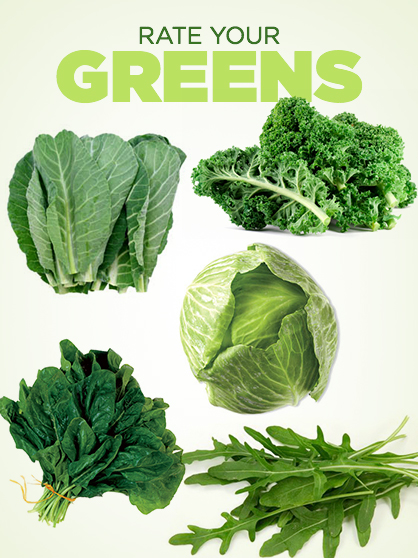Rate Your Greens for Fall
Remember how mom always told you to eat your greens? She was right. Leafy green vegetables are packed full of vitamins, minerals and disease-fighting phytochemicals. Fall is the best time to eat leafy greens, as they naturally grow better in colder weather, making them taste slightly sweeter and more flavorful. This allows them to be even more densely packed with antioxidants and nutrients.
While all greens are healthful, some are better than others. Make the most of your fall and winter greens choices by mixing it up and opting for a variety including kale, spinach, arugula, turnip greens, cabbage, swiss chard and collard greens. Find out which ones are packed with the most vitamins:
Good
.png)
Turnip Greens: These greens are a cousin to collard greens and are a solid source of vitamins A, C, E, and B6 as well as calcium and folic acid. The leaves are smaller than collard greens, and have a slight bitterness from the high calcium content. Turnip greens contain four times the calcium of other leafy greens such as cabbage. They are delectable sautéed with coconut oil and red pepper flakes.
Cabbage: This is a member of the cruciferous family and it contains a healthy amount of fiber, vitamin K and vitamin C. It’s said to have cholesterol-lowering benefits when steamed or eaten raw to preserve nutrients. Shred it to use in tacos or to top soups, or sauté with coconut oil and a sprinkle of sea salt to bring out the natural sweetness.
Whichever you choose, greens are highly nutritious foods that offer a variety of health benefits. They are rich in vitamins, minerals and antioxidants and can also minimize your risk of developing certain diseases. A recent Harvard-based study concluded that those who eat eight or more servings of fruits and vegetables daily, particularly green, leafy vegetables, are 30 percent less likely to have a stroke or heart attack. Eating greens may also protect against certain cancers, according to the American Institute for Cancer Research.
Better
.png)
Kale: This versatile and delicious superfood is rich in antioxidant vitamin K to fight cancer. It also contains calcium, and vitamins A and C. Vitamin C helps to boosts the immune system by fighting bacteria, viruses and infections. Kale also contains 36 milligrams of phosphorous per serving. This mineral supports cell growth and metabolizes proteins and glucose in your body. Kale ranges from deep purple to burgundy as well as traditional green, for extra-festive salads. The leaves can be tossed with olive oil and sea salt and crisped in the oven and eaten as chips, or sautéed in a skillet with olive oil and red pepper flakes. It’s also fantastic mixed into smoothies.
Arugula: This spicy green is also known as “rocket salad”. It has a kick and loses some of its bitterness in the fall, so it tastes sweeter and crisper. Mix it with other greens or use it on its own for a great salad. It’s considered one of the most healthy and useful natural foods. It’s loaded with vitamins A, P and C, as well as iron and potassium.
Collard Greens: Anyone who grew up in the South has tasted collard greens at least once. These greens are a staple in Southern cooking and are incredibly healthful with loads of vitamin K and calcium. Collard greens are one of the best cholesterol-lowering foods available and they’re full of antioxidants to reduce stress on your cells. Try dicing into small pieces and sautéing with onions and garlic for a true Southern treat.
Best

Swiss Chard: This vegetable features distinctly large dark-green leaves with a prominent stalk that is quite edible. When the leaves are small and young, the entire plant can be used in salads, and when the leaves are large and mature, the stalks can be cooked. The stalks can be white, red or multi-colored in a rainbow of pink, yellow, orange and purple. It’s full of anti-inflammatory and antioxidant properties, as well as iron, potassium, magnesium and vitamins A, C, E and K. Try sautéing the stalks with garlic and a splash of chicken broth until tender, then adding in the chopped leaves until wilted.
Spinach: Popeye knew what he was talking about. Spinach is a powerhouse of vitamins and nutrients. It’s a great source of iron and vitamins A, C and K. One cup of fresh spinach provides double the daily requirement of vitamin K. Spinach has also been found to boost your mood. This is especially helpful as the days get colder and darker in the fall . A fast way to prepare spinach is to sauté in olive oil with minced garlic and chunks of sea salt until wilted.
Sources: Nadia Tilkian, executive chef, Waterleaf; Jenny Giblin, nutrition coach and psychotherapist; Dr. Janet Brill, nutritionist and author

LadyLUX



